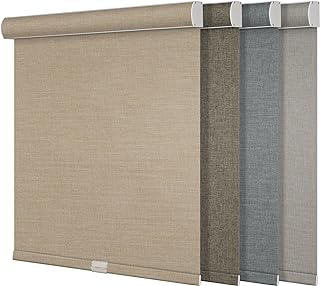Did you know that the average American household loses up to 30% of its heating and cooling energy through windows? That’s a staggering amount of energy wastage that directly translates into higher utility bills and increased carbon emissions. But fear not! In this comprehensive guide, we will show you how to choose energy efficient window coverings that not only insulate your space but also help you reduce energy consumption and create a more sustainable home environment.
Key Takeaways:
- Energy efficient window coverings can significantly reduce energy wastage through windows.
- Choosing sustainable window coverings helps save on utility bills and reduces carbon emissions.
- Insulation is a crucial factor to consider when selecting energy efficient window coverings.
- Options such as energy-saving curtains, eco-friendly shades, and thermal coverings provide effective insulation.
- Consider factors like material durability and aesthetic appeal to find the perfect solution for your home.
Understanding the Importance of Energy Efficient Window Coverings
Before we delve into the process of selecting the perfect window coverings for your home, it’s crucial to understand why energy efficiency is essential. Energy efficient blinds and other window treatments not only add style to your space but also offer significant benefits when it comes to insulation. By choosing the best window treatments for insulation, you can save energy and reduce your carbon footprint.
When it comes to creating an energy-efficient home, the windows are often overlooked. However, windows can be a significant source of heat gain or loss, leading to higher energy consumption and increased utility bills. Energy efficient window coverings act as a barrier, reducing the amount of heat that enters or escapes your home. This, in turn, helps to maintain a comfortable temperature and minimizes the need for excessive heating or cooling.
The right window coverings can also help to regulate natural light, providing UV protection and reducing glare. By using blinds that allow you to control the amount of sunlight entering a room, you can limit the need for artificial lighting, further reducing energy consumption.
Energy efficient blinds and other window treatments not only add style to your space but also offer significant benefits when it comes to insulation.
Furthermore, investing in energy efficient window coverings is a sustainable choice that contributes to environmental conservation. By reducing your energy consumption, you can help reduce greenhouse gas emissions and combat climate change. Additionally, energy efficient window coverings can enhance the value and appeal of your home, making it more attractive to potential buyers if you decide to sell in the future.
When selecting energy efficient blinds, consider factors such as material composition, insulation properties, and the overall design aesthetics. Look for options that are specifically designed to provide insulation and minimize heat transfer, such as cellular shades or insulated roller blinds. These innovative window coverings are built with multiple layers and reflective materials that trap air and create a barrier against heat loss or gain.
By understanding the importance of energy efficient window coverings, you can make informed choices that not only enhance the comfort and style of your home but also contribute to a more sustainable future.
Different Types of Energy Efficient Window Coverings
1. Energy-Saving Curtains

When it comes to choosing eco-friendly window coverings, there are several options available in the market. Each type offers unique benefits that contribute to energy savings and a more sustainable home environment. In this section, we will explore three popular choices: energy-saving curtains, eco-friendly window shades, and thermal coverings. By understanding the features and advantages of these window coverings, you can make an informed decision for your home.
Energy-saving curtains are designed to minimize heat transfer through windows, thereby reducing the need for excessive heating or cooling. These curtains are typically constructed with multiple layers, including an insulating core and a light-blocking layer. This combination helps to regulate indoor temperatures, making your home more energy-efficient.
Additionally, energy-saving curtains offer enhanced privacy and light control, allowing you to create a comfortable and cozy atmosphere in your living spaces. Their insulating properties also contribute to noise reduction, creating a quieter and more peaceful environment.
2. Eco-Friendly Window Shades
Eco-friendly window shades are another excellent option for energy-efficient window coverings. These shades are commonly made from sustainable materials such as bamboo, jute, or other natural fibers. By choosing eco-friendly window shades, you can reduce your carbon footprint and create a healthier indoor environment.
These shades are known for their ability to block harmful UV rays, preventing furniture and flooring from fading due to sun exposure. Additionally, eco-friendly window shades provide excellent insulation, reducing heat gain in the summer and heat loss in the winter. This leads to energy savings and increased comfort throughout the year.
3. Thermal Window Coverings
Thermal window coverings, also known as insulated blinds or shades, are specifically designed to provide excellent insulation properties. These coverings are often constructed with multiple layers of fabric or cellular structures that trap air, creating a barrier against heat transfer.
Thermal window coverings effectively regulate indoor temperatures, reducing the need for excessive heating or cooling. They help keep your home cozy during cold winter months and prevent heat gain in the summer, leading to significant energy savings.
Furthermore, thermal coverings offer privacy and light control, allowing you to adjust the amount of natural light entering your space. Their insulating properties also contribute to noise reduction, creating a quieter and more peaceful environment.
Now that you have learned about the different types of energy efficient window coverings available, you can evaluate the features and benefits of each option to select the most suitable solution for your home. By choosing eco-friendly window shades, energy-saving curtains, or thermal coverings, you can enhance energy efficiency while creating a stylish and comfortable living space.
Factors to Consider When Choosing Energy Efficient Window Coverings
When selecting energy efficient window coverings for your home, it’s important to consider a variety of factors that will contribute to the overall performance and effectiveness of the window treatments. By carefully assessing insulation, material durability, and aesthetic appeal, you can make an informed decision that meets your specific needs while reducing energy consumption and saving on heating and cooling costs.
Insulation: Keeping Energy In and Keeping the Elements Out
One of the primary purposes of energy efficient window coverings is to provide insulation, helping to keep warm air inside during the winter months and preventing heat from entering during the summer. Look for coverings that offer high levels of insulation to effectively reduce heat transfer through your windows.
In addition to insulation, consider the seals around your windows and any potential sources of drafts. Properly fitted window coverings can help create a tighter seal, further enhancing the energy efficiency of your home.
Durability: Long-Lasting Investment for Energy Efficiency
Investing in durable window coverings is essential for long-term energy efficiency. Look for materials that are designed to withstand the test of time and regular use. Durable coverings will not only provide effective insulation but will also maintain their aesthetic appeal and functionality over the years.
Consider the quality of the materials used in the window coverings, such as sturdy fabrics or reinforced construction. High-quality coverings will serve as a long-lasting investment and continue to contribute to energy efficiency throughout their lifespan.
Aesthetic Appeal: Blending Style and Sustainability
Energy efficient window coverings should not only be functional but should also complement the overall aesthetic of your home. Consider the style, color, and design options available to ensure the coverings seamlessly blend with your existing decor.
By finding window coverings that combine both style and sustainability, you can create a harmonious and energy-efficient living space.
| Factors to Consider | Insulation | Durability | Aesthetic Appeal |
|---|---|---|---|
| Importance | High | High | Medium |
| Top Rated Option | Insulating Drapes | Various | Insulating Drapes |
Conclusion
In conclusion, when deciding how to choose energy efficient window coverings, it’s important to consider the various options available. Energy efficient blinds, such as cellular shades or honeycomb blinds, are a popular choice for their insulation properties and ability to regulate heat and light. They can significantly reduce energy loss and offer a visually appealing window treatment solution.
If you’re looking for the best window treatments for insulation, thermal window coverings, like insulating drapes or blackout curtains, are highly effective. They provide an additional layer of insulation, preventing drafts and heat transfer, which can lead to energy savings throughout the year.
Eco-friendly window shades made from sustainable materials, such as bamboo or organic fabrics, are not only energy efficient but also contribute to a greener future. These shades help reduce heat gain in the summer and heat loss in the winter, making them an eco-conscious choice.
Whether you opt for energy saving curtains, sustainable window coverings, or top rated insulating drapes, the key is to prioritize factors like insulation, durability, and aesthetic appeal. By doing so, you can select the perfect energy efficient window treatment options that suit your needs while reducing your environmental impact.

